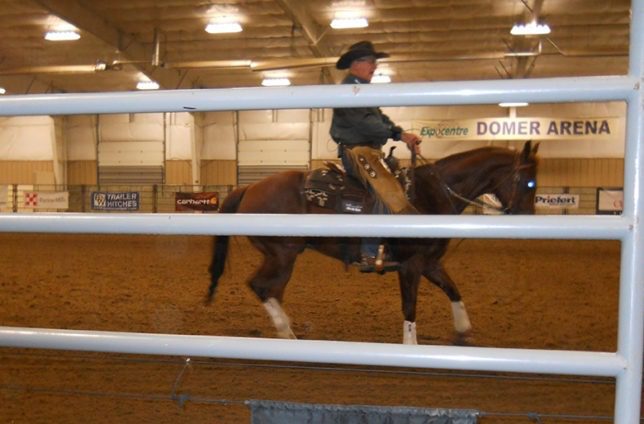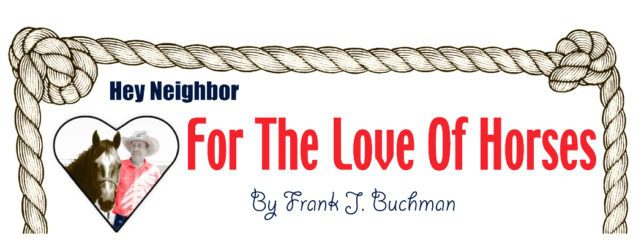“A versatile horse fits most owners’ needs.”
Renowned-trainer Al Dunning discussed requirements for meeting those basics during a Purina Horse Owner’s Workshop in Topeka.
As part of the Al Dunning Experience, coordinated by Purina Mills Regional Manager Ernie Rodina, the evening-program was free to the public with a large attendance of diverse ability-level horse enthusiasts.

Renowned-trainer Al Dunning discussed requirements for meeting those basics during a Purina Horse Owner’s Workshop in Topeka.
As part of the Al Dunning Experience, coordinated by Purina Mills Regional Manager Ernie Rodina, the evening-program was free to the public with a large attendance of diverse ability-level horse enthusiasts.
Four days of individual-tutoring a dozen horse owners and their personal mounts were presented by Dunning and three of his prodigy-trainers during “The Experience.” For a small fee, the public could monitor those sessions as well.
Singer Rusty Rierson entertained the “HOW” group before Rodina introduced sponsors, participants, and emphasized the importance of correct nutrition for maximum horse performance.
“Every horse varies in their dietary-needs, so the ration must be figured exactly for them. It may not even be similar to the horses stalled nearby,” Rodina stressed.
Mounted on a sorrel mare called Jewell, owned by one of his customers, Dunning emphasized: “Horsemanship is 50 percent hands and 50 percent feet.”
Dunning, who headquarters on his AD Ranch in Scottsdale, Arizona, explained, “Bending is the most important part of everything a horse does. The horse continues to lighten up with increased bending.”
Posture is as important in the saddle as it is walking, according to Dunning, as he dismounted and demonstrated.
“Your body should be balanced with the shoulders in line with the hips which are perpendicular to the legs around the horse with your toes out. You must sit up in the saddle with a relaxed back in the center of the horse, so you can stand up at any time.
“Hands must be in the ‘box,’ right in front of the saddle horn,” he added.
Wearing a rawhide “bosal” hackamore, Jewell responded to soft “one-rein” maneuvers, as her head was lightly directed one direction with the inside rein, and the outside rein remained limp.
“Your leg and heel must exert pressure on the same-side your horse is bending,” Dunning indicated.
Everything asked of the horse can be developed from that basic-beginning, Dunning qualified as he performed with the mare at the walk, jog, and lope, and then had her “two-track,” side-pass, stop and back with cues almost-invisible to lay spectators.
“It’s essential to keep her loose on the front, so she can get her butt down to move, turn and stop,” said Dunning, as he lightly reprimanded Jewell, completely unapparent to the crowd.
“I’ve really intimidated her. That was severe for me, and you didn’t even see it,” he pointed out.
Lead changes were demonstrated as Dunning reiterated, “Your hands steer the front end, and your feet guide the back.”
While changing horses, Dunning talked about his background including setbacks and hardships with horses that eventually became champions because of his belief in their ability and persistency with them to achieve that level of proficiency.
“It’s never about me. It’s about the horse,” Dunning demanded. “You have to feel your horse, who is completely dependent on you for guidance.”
Remembering a couple of the horses he’s shown successfully and turned down large-offers to sell, Dunning said, “No amount of money could replace those horses.”
Pedigree of the sorrel gelding called Lucky was recited by Dunning as he adjusted stirrups and then stepped into the saddle, while recalling many setbacks of the horse and its family for several generations.
“Lucky is my rope horse,” Dunning described, although admitting the gelding had qualified for world show competition in working cow horse classes.
Adjusting a snaffle bit and tightening a running martingale on his mount, Dunning recognized, “I start all of my horses with a snaffle bit. There are all kinds of snaffle bits, and they all do good for a horse, even when a horse is older and well-trained like Lucky.”
Riding his rope horse, Lucky, horse trainer Al Dunning demonstrated use of the “CowTrac Ultimate Mechanical Cow System,” foreground, as initial training for working cow horses and cutting horses during a Purina Mills Horse Owner’s Workshop in Topeka.
With a device similar to what some cattle-horse trainers refer to as a “flag,” Dunning had his “CowTrac Ultimate Mechanical Cow System” installed on the fence to show how horses are started and refreshed on the basics of working cattle.
As Dunning controlled the “CowTrac” up and down the fence at various speeds with a hand-held device, he guided Lucky as if working a live cow.
“When the cow stops, the horse must stop. When the cow turns, the horse must turn,” Dunning showed.
As the “CowTrac” picked up speed, Lucky responded with increased pace working steadily off his hocks, with no pressure from his rider, and complete freedom of the front end.
Moving into another pen, Dunning then worked live cattle in similar form.
After introducing his mount to the cow, Dunning contended, “We must be in control of her at all times, but form is essential in order to accomplish that.”
In conclusion, Dunning summarized, “Remember your horse depends on you for everything. How much you achieve largely hinges on your horsemanship.”
Four days of individual-tutoring a dozen horse owners and their personal mounts were presented by Dunning and three of his prodigy-trainers during “The Experience.” For a small fee, the public could monitor those sessions as well.
Singer Rusty Rierson entertained the “HOW” group before Rodina introduced sponsors, participants, and emphasized the importance of correct nutrition for maximum horse performance.
“Every horse varies in their dietary-needs, so the ration must be figured exactly for them. It may not even be similar to the horses stalled nearby,” Rodina stressed.
Mounted on a sorrel mare called Jewell, owned by one of his customers, Dunning emphasized: “Horsemanship is 50 percent hands and 50 percent feet.”
Dunning, who headquarters on his AD Ranch in Scottsdale, Arizona, explained, “Bending is the most important part of everything a horse does. The horse continues to lighten up with increased bending.”
Posture is as important in the saddle as it is walking, according to Dunning, as he dismounted and demonstrated.
“Your body should be balanced with the shoulders in line with the hips which are perpendicular to the legs around the horse with your toes out. You must sit up in the saddle with a relaxed back in the center of the horse, so you can stand up at any time.
“Hands must be in the ‘box,’ right in front of the saddle horn,” he added.
Wearing a rawhide “bosal” hackamore, Jewell responded to soft “one-rein” maneuvers, as her head was lightly directed one direction with the inside rein, and the outside rein remained limp.
“Your leg and heel must exert pressure on the same-side your horse is bending,” Dunning indicated.
Everything asked of the horse can be developed from that basic-beginning, Dunning qualified as he performed with the mare at the walk, jog, and lope, and then had her “two-track,” side-pass, stop and back with cues almost-invisible to lay spectators.
“It’s essential to keep her loose on the front, so she can get her butt down to move, turn and stop,” said Dunning, as he lightly reprimanded Jewell, completely unapparent to the crowd.
“I’ve really intimidated her. That was severe for me, and you didn’t even see it,” he pointed out.
Lead changes were demonstrated as Dunning reiterated, “Your hands steer the front end, and your feet guide the back.”
While changing horses, Dunning talked about his background including setbacks and hardships with horses that eventually became champions because of his belief in their ability and persistency with them to achieve that level of proficiency.
“It’s never about me. It’s about the horse,” Dunning demanded. “You have to feel your horse, who is completely dependent on you for guidance.”
Remembering a couple of the horses he’s shown successfully and turned down large-offers to sell, Dunning said, “No amount of money could replace those horses.”
Pedigree of the sorrel gelding called Lucky was recited by Dunning as he adjusted stirrups and then stepped into the saddle, while recalling many setbacks of the horse and its family for several generations.
“Lucky is my rope horse,” Dunning described, although admitting the gelding had qualified for world show competition in working cow horse classes.
Adjusting a snaffle bit and tightening a running martingale on his mount, Dunning recognized, “I start all of my horses with a snaffle bit. There are all kinds of snaffle bits, and they all do good for a horse, even when a horse is older and well-trained like Lucky.”
With a device similar to what some cattle-horse trainers refer to as a “flag,” Dunning had his “CowTrac Ultimate Mechanical Cow System” installed on the fence to show how horses are started and refreshed on the basics of working cattle.
As Dunning controlled the “CowTrac” up and down the fence at various speeds with a hand-held device, he guided Lucky as if working a live cow.
“When the cow stops, the horse must stop. When the cow turns, the horse must turn,” Dunning showed.
As the “CowTrac” picked up speed, Lucky responded with increased pace working steadily off his hocks, with no pressure from his rider, and complete freedom of the front end.
Moving into another pen, Dunning then worked live cattle in similar form.
After introducing his mount to the cow, Dunning contended, “We must be in control of her at all times, but form is essential in order to accomplish that.”
In conclusion, Dunning summarized, “Remember your horse depends on you for everything. How much you achieve largely hinges on your horsemanship.”
+++
